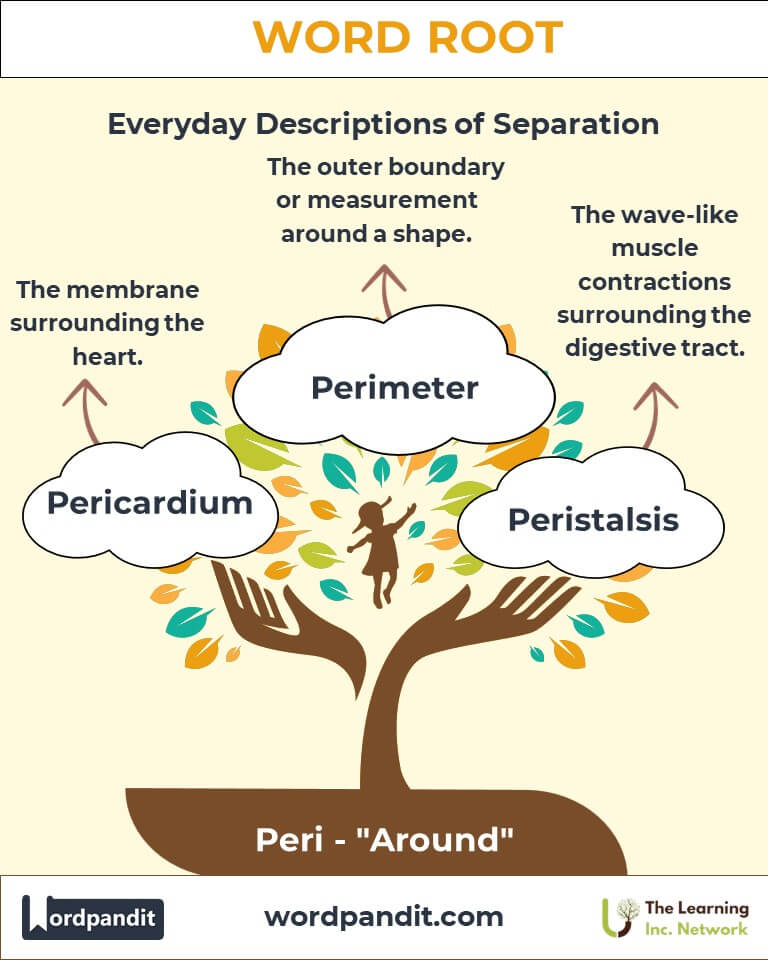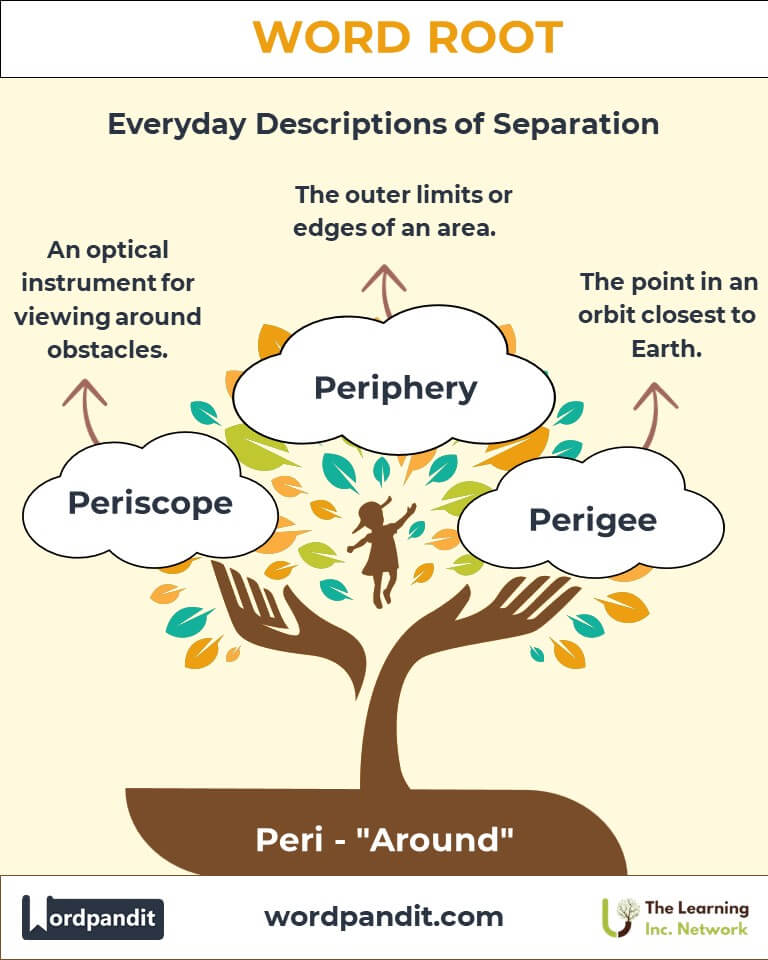Peri: The Root of Surrounding and Encompassing
Byline:
Discover the significance of the root "peri," derived from Greek, meaning "around." This versatile root shapes words from "perimeter" to "peripheral," encapsulating concepts of boundaries, surroundings, and lateral vision across diverse fields.

Table of Contents
- Introduction: The Essence of Peri
- Etymology and Historical Journey
- Mnemonic: Unlocking the Power of Peri
- Common Peri-Related Terms
- Peri Through Time
- Peri in Specialized Fields
- Illustrative Story: Peri in Action
- Cultural Significance of the Peri Root
- The Peri Family Tree
- FAQs about the Peri Word Root
- Test Your Knowledge: Peri Mastery Quiz
- Conclusion: The Living Legacy of Peri
Introduction: The Essence of Peri
What do a fence encircling a garden and your side vision have in common? Both are described using the root "peri," from the Greek word meaning "around." Pronounced "peh-ree," this root is a linguistic cornerstone for words about boundaries, edges, and surrounding areas. From geometric perimeters to peripheral vision in biology, "peri" finds relevance in disciplines as varied as mathematics, medicine, and literature.

Etymology and Historical Journey
The root "peri" comes from the Greek preposition "peri," meaning "around" or "about." It entered English through Latinized Greek during the Renaissance, when classical texts were translated and studied extensively. "Peri" has been used to describe physical boundaries (e.g., perimeter) and abstract concepts (e.g., periphery) that highlight edges or surroundings.
Mnemonic: Unlocking the Power of Peri
To remember "peri," picture a pirate's parrot circling around their shoulder. The word parrot sounds similar to "peri," and its continuous movement "around" encapsulates the meaning of the root.
Mnemonic:
"Peri: Picture a parrot flying around to guard its pirate!"
Common Peri-Related Terms
- Perimeter: The boundary or edge around a geometric shape.
Example: "The gardener measured the perimeter of the field before planting the fence." - Peripheral: Related to the outer edges or areas; not central.
Example: "Her peripheral vision caught the speeding car approaching from the side." - Periscope: An optical device allowing one to see around or above obstacles.
Example: "The submarine captain used the periscope to check for ships above the water." - Peristyle: A row of columns surrounding a space or building.
Example: "The ancient Greek temple was adorned with a grand peristyle." - Pericardium: A double-layered sac surrounding the heart.
Example: "The pericardium protects the heart from physical damage."
Peri Through Time
- Periphrasis: Originally used in ancient rhetoric, this term describes a verbose way of saying something.
Example: "A lengthy circumlocution is a form of periphrasis." - Periphery: Initially describing outskirts of towns, this term now applies to metaphorical boundaries.
Example: "The artist thrived on the periphery of mainstream society."
Peri in Specialized Fields
- Medicine: Pericardium protects the heart; Peritonitis describes inflammation of the abdominal membrane.
- Geometry: Perimeter measures the length around shapes.
- Astronomy: Perigee refers to the closest point in a celestial body’s orbit to Earth.
- Optics: Peripheral vision detects motion and enhances spatial awareness.
Illustrative Story: Peri in Action
Eli, a wildlife photographer, relied heavily on his peripheral vision to spot elusive animals. While hiking around the perimeter of a forest, he discovered a hidden lake surrounded by columns resembling a Greek peristyle. Using his periscope-like telephoto lens, he captured rare shots of birds flying in circular patterns, embodying the essence of "peri" in his adventure.
Cultural Significance of the Peri Root
"Peri" often appears in myths and arts as a metaphor for encompassing perspectives. In Persian folklore, the "peri" is a supernatural being, likened to a fairy that surrounds humans with beauty and mystery. The root also finds philosophical significance in writings about boundaries and limits, such as the concept of life's periphery.

The Peri Family Tree
Related Roots:
1. Circum- (Latin: "around")
- Circumference: The distance around a circle.
- Circumnavigate: To sail around the globe.
2. Ambi- (Latin: "both sides")
- Ambiguous: Open to multiple interpretations.
- Ambidextrous: Able to use both hands equally well.
3. Environ- (French/Latin: "surround")
- Environment: The surroundings in which something exists.
- Environs: The area surrounding a place.

FAQs About the "Peri" Word Root
Q: What does "peri" mean, and what is its origin?
A: The root "peri" means "around" or "about." It originates from the Greek preposition "peri," which describes encircling or surrounding. This root forms the basis of English words that indicate physical, spatial, or abstract boundaries.
Q: What is the difference between "perimeter" and "circumference"?
A: Both terms describe boundaries, but "perimeter" refers to the total length of any shape's boundary, including polygons like rectangles. "Circumference" is specific to circles, describing the distance around them.
Q: What is peripheral vision, and why is it important?
A: Peripheral vision is the ability to see objects outside your direct line of sight. It is crucial for detecting motion, maintaining balance, and improving spatial awareness, aiding activities like driving, sports, and navigation.
Q: What does a periscope do, and where is it used?
A: A periscope is an optical device that allows users to see over, under, or around obstacles using mirrors or prisms. It is commonly used in submarines, armored vehicles, and toys to explore areas beyond direct view.
Q: How is "peri" used in astronomy?
A: In astronomy, "peri" appears in terms like "perigee," which describes the point in a celestial body's orbit closest to Earth. For example, a supermoon occurs when the moon reaches its perigee, appearing larger and brighter.
Test Your Knowledge: "Peri" Word Root Quiz
1. What does "peri" mean?
2. What is the role of the pericardium?
3. What does "peripheral" mean?
4. Which tool uses mirrors to view "around" obstacles?
5. What is the perimeter of a square with 5m sides?
Conclusion: The Living Legacy of Peri
The root "peri" weaves through language to define boundaries, surroundings, and the edges of perception. From protecting our hearts (pericardium) to exploring boundaries (perimeter), its applications are vast and vital. As new discoveries emerge, "peri" will continue to circle around and encompass our understanding of the world.












